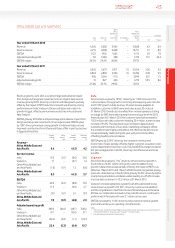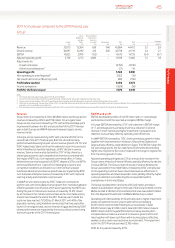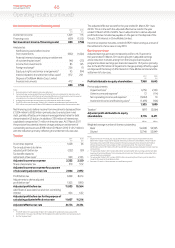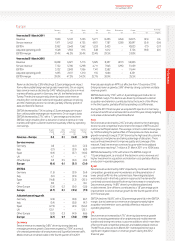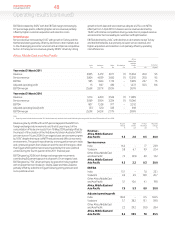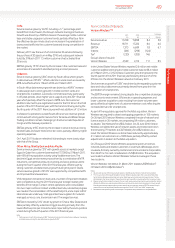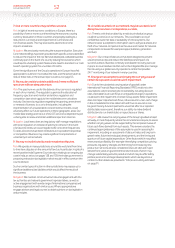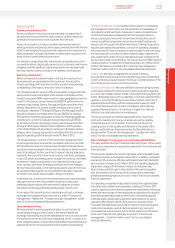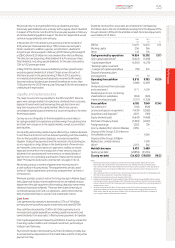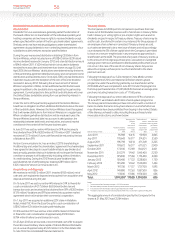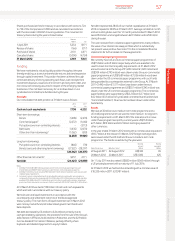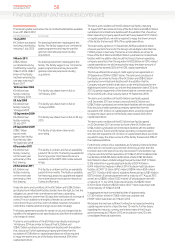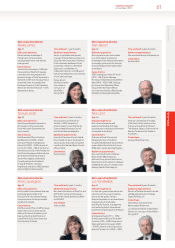Vodafone 2012 Annual Report Download - page 53
Download and view the complete annual report
Please find page 53 of the 2012 Vodafone annual report below. You can navigate through the pages in the report by either clicking on the pages listed below, or by using the keyword search tool below to find specific information within the annual report.
Business review Performance Governance Financials Additional information
51
Vodafone Group Plc
Annual Report 2012
Principal risk factors and uncertainties
1. Regulatory decisions and changes in the regulatory
environment could adversely affect our business.
Risk: We have ventures in both emerging and mature markets, spanning
a broad geographical area including Europe, Africa, Middle East, Asia
Pacic and the United States. We need to comply with an extensive
range of requirements that regulate and supervise the licensing,
construction and operation of our telecommunications networks and
services. Pressure on political and regulatory institutions both to deliver
direct consumer benet and protect consumers interests, particularly
inrecessionary periods, can lead to adverse impacts on our business.
Financial pressures on smaller competitors can drive them to call
forregulators to protect them. Increased nancial pressures on
governments may lead them to target foreign investors for further
taxesor licence fees.
Mitigation: We monitor political developments in our existing and
potential markets closely, identifying risks in our current and proposed
commercial propositions. Regular reports are made to our Executive
Committee on current political and regulatory risks. These risks are
considered in our business planning process, including the importance
of competitive commercial pricing and appropriate product strategies.
Authoritative and timely intervention is made at both national and
international level in respect of legislative, scal and regulatory
proposals which we feel are not in the interests of the Group. We have
regular dialogue with trade groups that represent network operators
and other industry bodies to understand underlying political pressures.
2. We could suffer loss of consumer condence and/or legal
action due to a failure to protect our customer information.
Risk: Mobile networks carry and store large volumes of condential
personal and business voice trafc and data. We host increasing
quantities and types of customer data in both enterprise and consumer
segments. We need to ensure our service environments are sufciently
secure to protect us from loss or corruption of customer information.
Failure to adequately protect customer information could have a
material adverse effect on our reputation and may lead to legal action
against the Group.
Mitigation: Both the hardware and software applications which hold
ortransmit condential personal and business voice and data trafc
include security features. Security related reviews are conducted
according to our policies and security standards. Security governance
and compliance is managed and monitored through software tools that
are deployed to all local markets and selected partner markets. Our data
centres are managed to international information security standards.
Third party data security reviews are conducted jointly with our
technology security and corporate security functions.
3. Our business could be adversely affected by a failure or
signicant interruption to telecommunications networks.
Risk: We are dependent on the continued operation of
telecommunications networks. As the importance of mobile
communication in everyday life, as well as during times of crisis,
increases, organisations and individuals look to us to maintain service.
Major failures in the network may result in service being interrupted
resulting in serious damage to our reputation and consequential
customer and revenue loss.
Mitigation: Specic back-up and resilience requirements are built into
our networks. We monitor our ability to replace strategic equipment
quickly in event of failure, and for high risk components, we maintain
dedicated back-up equipment ready for use. Dedicated access network
equipment is installed on trucks ready to be moved on site if required.
Network contingency plans are linked with our overall business
continuity and crisis management plans. A crisis management team and
escalation processes are in place both nationally and internationally, and
crisis simulations are conducted annually.
4. Technological advances in handsets and use of alternative
communication services may result in less demand for our
traditional service offerings.
Risk: Strategic handset and technology suppliers are developing mobile
content and services. Advancements in smartphone branding and
technology places more focus on devices rather than the underlying
services provided by mobile operators. The development of applications
which make use of the internet as a substitute for some of our more
traditional services, such as messaging and voice, could erode revenue.
Reduced demand for our core services of voice, messaging and
dataand the development of services by handset suppliers could
signicantly impact our future protability.
Mitigation: We have developed strategies which strengthen our
relationships with customers, including the development of our own
branded products, offering a broad selection of handsets and devices
from a variety of manufacturers and providing our own alternatives to
our more traditional services. We have accelerated the introduction
ofintegrated voice, messaging and data tariffs to minimise customers
reducing their out-of-bundle usage through substitution.
5. Increased competition may reduce our market share and
protability.
Risk: We face intensifying competition; in particular competing with
established competitors in mature markets and competing with new
entrants in emerging markets, where all operators are looking to secure
a share of the potential customer base. Competition could lead to a
reduction in the rate at which we add new customers, a decrease in
thesize of our market share and a decline in our average revenue per
customer, as customers may choose to receive telecommunications
services or other competing services from alternate providers.
Competition can also lead to an increase in customer acquisition
andretention costs. The focus of competition in many of our markets
has shifted from acquiring new customers to retaining existing
customers, as the market for mobile telecommunications has become
increasinglymature.
Mitigation: We will continue to promote our differentiated propositions
by focusing on our points of strength such as network quality, capacity
and coverage, quality of customer service and the value of our products
and services. We are enhancing distribution channels to get closer
tocustomers and using targeted promotions where appropriate to
attractand retain specic customers. We closely monitor and model
competitor behaviour, network builds and product offerings to
understand future intentions to be able to react in a timely manner.
6. Our business may be impaired by actual or perceived health
risks associated with the transmission of radio waves from
mobile telephones, transmitters and associated equipment.
Risk: Concerns have been expressed that the electromagnetic
signalsemitted by mobile telephone handsets and base stations may
pose health risks. We are not aware that such health risks have been
substantiated, however, in the event of a major scientic nding
supporting this view this might result in prohibitive legislation being
introduced by governments (or the European Union), a major reduction in
mobile phone usage (especially by children), a requirement to move base
station sites, signicant difculty renewing or acquiring site leases and/or
major litigation. An inadequate response to electromagnetic elds (‘EMF’)
issues may result in loss of condence in the industry andVodafone.
Mitigation: We have a global health and safety policy that includes
standards for radio frequency elds that are mandated in all our
operating companies. We have a Group EMF board that manages
potential risks through cross sector initiatives and who oversee a
coordinated global programme to address and reduce public concern.
We have close engagement with EU institutions, in coordination with
aninternational policy team in Brussels, to ensure early warning and
advocacy related to possible precautionary legislation. We are engaged
with relevant bodies to ensure that the scientic research agenda set by
the World Health Organization is fully funded and executed as fast as
reasonably possible.




